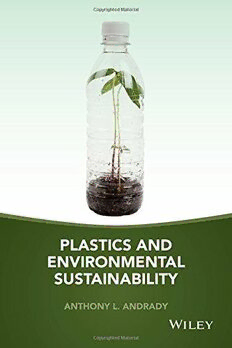Table Of ContentPlastics and EnvironmEntal
sustainability
Plastics and
EnvironmEntal
sustainability
anthony l. andrady, Ph.d
Adjunct Professor of Chemical and Biomolecular Engineering
North Carolina State University
Copyright © 2015 by John Wiley & Sons, Inc. All rights reserved
Published by John Wiley & Sons, Inc., Hoboken, New Jersey
Published simultaneously in Canada
No part of this publication may be reproduced, stored in a retrieval system, or transmitted in any form
or by any means, electronic, mechanical, photocopying, recording, scanning, or otherwise, except as
permitted under Section 107 or 108 of the 1976 United States Copyright Act, without either the prior
written permission of the Publisher, or authorization through payment of the appropriate per‐copy fee to
the Copyright Clearance Center, Inc., 222 Rosewood Drive, Danvers, MA 01923, (978) 750‐8400, fax
(978) 750‐4470, or on the web at www.copyright.com. Requests to the Publisher for permission should
be addressed to the Permissions Department, John Wiley & Sons, Inc., 111 River Street, Hoboken, NJ
07030, (201) 748‐6011, fax (201) 748‐6008, or online at http://www.wiley.com/go/permissions.
Limit of Liability/Disclaimer of Warranty: While the publisher and author have used their best efforts
in preparing this book, they make no representations or warranties with respect to the accuracy or
completeness of the contents of this book and specifically disclaim any implied warranties of
merchantability or fitness for a particular purpose. No warranty may be created or extended by sales
representatives or written sales materials. The advice and strategies contained herein may not be suitable
for your situation. You should consult with a professional where appropriate. Neither the publisher nor
author shall be liable for any loss of profit or any other commercial damages, including but not limited
to special, incidental, consequential, or other damages.
For general information on our other products and services or for technical support, please contact our
Customer Care Department within the United States at (800) 762‐2974, outside the United States at
(317) 572‐3993 or fax (317) 572‐4002.
Wiley also publishes its books in a variety of electronic formats. Some content that appears in print may
not be available in electronic formats. For more information about Wiley products, visit our web site at
www.wiley.com.
Library of Congress Cataloging‐in‐Publication Data:
Andrady, A. L. (Anthony L.)
Plastics and environmental sustainability / Anthony L. Andrady, PhD.
pages cm
Includes bibliographical references and index.
ISBN 978-1-118-31260-5 (cloth)
1. Plastics–Environmental aspects. 2. Plastics–Health aspects. 3. Plastics–Biodegradation. I. Title.
TD798.A53 2015
628.4′4–dc23
2014042233
Cover image courtesy of iStockphoto©Devonyu
Set in 10/12pt Times by SPi Publisher Services, Pondicherry, India
Printed in the United States of America
10 9 8 7 6 5 4 3 2 1
1 2015
This book is dedicated to my children
and my grandchildren.
contents
Preface xiii
Acknowledgments xvii
List of Plastic Materials xix
1 the Anthropocene 1
1.1 Energy Futures 6
1.1.1 Fossil Fuel Energy 8
1.1.1.1 Oil 8
1.1.1.2 Coal 9
1.1.1.3 Gas 10
1.1.1.4 Nuclear Energy 11
1.1.2 Renewable Energy 12
1.1.2.1 Wind Energy 12
1.1.2.2 Solar Energy 13
1.1.2.3 Solar Biomass Energy 13
1.2 Materials Demand in the Future 14
1.2.1 Materials of Construction 15
1.2.2 Metal Resources 16
1.2.3 Critical Materials 18
1.2.4 Plastic Materials 19
1.3 Environmental Pollution 22
1.3.1 Classifying Pollution Impacts 23
1.3.2 Climate Change and Global Warming 24
References 27
viii CONtENtS
2 A sustainability Primer 31
2.1 the Precautionary Principle 33
2.1.1 Objectives in Sustainability 35
2.2 Microeconomics of Sustainability: the Business Enterprise 36
2.3 Models on Implementing Sustainability 38
2.4 Life Cycle Analysis 41
2.5 the Emerging Paradigm and the Plastics Industry 44
2.5.1 Examples from Plastics Industry 47
2.5.1.1 Using the Minimum Energy Needed to Manufacture
Products 47
2.5.1.2 Using the Energy Mix with a Minimal Environmental
Footprint 47
2.5.1.3 Recovering Waste Process Energy for Reuse 48
2.5.1.4 Using Only as Much Material as Is Needed to Ensure
Functionality 48
2.5.1.5 Using More of Renewable and Recycled
Raw Materials 48
2.5.1.6 Reusing and Recycling Postuse Products 49
2.5.1.7 Minimizing Externalities at Source: Green
Chemistry 49
2.5.1.8 Avoiding toxic Components and Potential Hazards
Associated with Products and Processes 50
2.5.1.9 Converting the Pollutants into Resources 50
References 51
3 An Introduction to Plastics 55
3.1 Polymer Molecules 56
3.1.1 Size of Polymer Molecules 57
3.2 Consequences of Long‐Chain Molecular Architecture 59
3.2.1 Molecular Weight of Chain Molecules 59
3.2.2 tacticity 61
3.2.3 Partially Crystalline Plastics 62
3.2.4 Chain Branching and Cross‐Linking 63
3.2.5 Glass transition temperature 66
3.3 Synthesis of Polymers 67
3.3.1 Addition or Chain Growth Reaction 68
3.3.2 Condensation or Step Growth Reaction 69
3.3.3 Copolymers 72
3.4 testing of Polymers 72
3.4.1 tensile Properties 73
3.4.2 thermal Properties: DSC (Differential Scanning Calorimetry) 74
3.4.3 thermal Properties: tGA 76

